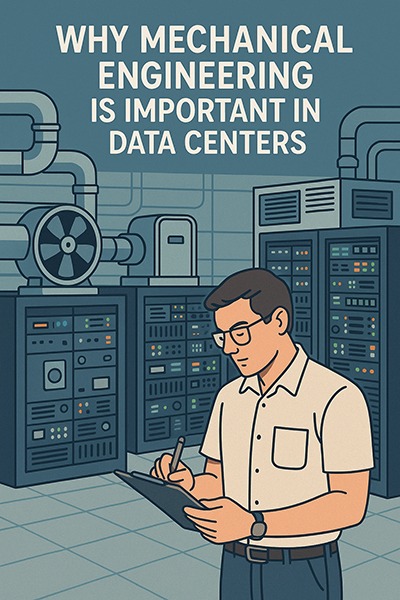Data centers are a crucial part of our modern society. Data centers, ranging in size from small enterprise rooms, to massive hyperscale facilities, house the IT equipment that stores and processes massive amounts of information. Handling everything from website traffic to complex computational tasks and the latest AI innovations, our world would look very different without these critical facilities.
But behind the scenes of the latest games, apps, and AI chatbots, a significant amount of mechanical engineering must take place to ensure the performance and reliability of the equipment, and that the buildings performance meets the expectations of the data center operators.
In Part 1 of our series, “Why Mechanical Engineering is Crucial to Data Centers”, we’ll cover what Mechanical Engineering means in a data center environment.
What do Mechanical Engineers do?
When most people think about data centers and the technology sector, they think about software, coding, servers, and rows and rows of racks. But the physical environment supporting all of that equipment is just as crucial. Servers, routers, and other IT equipment generate significant amounts of heat during operation. Overheating can quickly lead to equipment failure and data losses, not to mention the financial repercussions. Mechanical engineers are responsible for designing the crucial cooling systems to prevent overheating.
Put simply, mechanical engineers design the Heating, Ventilation, and Air Conditioning (HVAC) systems that keep the data center running. Due to the nature of how data centers work, that means they spend a significant amount of time on the cooling systems. This includes cooling for occupied areas (support offices, a network operations center (NOC), security offices etc.), as well as the IT spaces. These systems are critical in data centers, if the cooling fails, the IT equipment will shut down to prevent thermal overload.

Without Mechanical Engineers, AI couldn’t generate fun photos like this one.
To prevent this, mechanical engineers must make decisions on the types of cooling systems for the data center. The type of cooling required is based on the type of IT equipment being installed, such as cloud servers, storage, or AI. Traditionally, a raised floor with perimeter CRAC or CRAH units was enough to cool the equipment. Hyperscale operators have generally opted for fan walls and hot aisle containment for cloud deployments, while AI deployments generally require some form of liquid cooling solution, with the latest AI chips requiring direct-to-chip liquid cooking.
Mechanical engineers perform calculations such as thermal load calculations, flow. and pressure drop calculations. This is done to size equipment, including chillers, dry coolers, pumps, air handlers, CRAC units, and other equipment. Mechanical engineers also make decisions on chilled water systems and piping, condensate drainage, leak detection, humidity control, and pressurization. ME’s use ASHRAE guidelines and coordinate with the electrical engineering team to ensure the PUE (power usage effectiveness) of the data center is maximized. Lastly, ME’s must plan for redundancy per the owners requirements, ensuring cooling systems have backups (N+1, 2N, etc.), allowing the data center to maintain uptime during failures or preventive maintenance events.
Conclusion
Mechanical engineering is crucial to the successful operation of data centers. Their designs ensure that servers stay cool and operation, manage airflow and humidity, and ensure the data center operates efficiently.
We hope you enjoyed our first blog post on mechanical engineering in data centers. In future posts, we’ll dive deeper into topics such as Cooling Systems, Airflow Management and Containment Strategies, and Energy Efficiency.
If you have a topic you would like to see us cover, please let us know!
